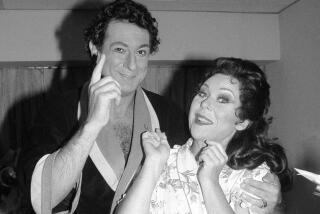The dramatic life of Mozart’s librettist
- Share via
The Librettist of Venice
The Remarkable Life of Lorenzo Da Ponte: Mozart’s Poet, Casanova’s Friend, and Italian Opera Impresario in America
Rodney Bolt
Bloomsbury: 430 pp., $29.95
*
AS the subtitle of Robert Bolt’s engaging biography “The Librettist of Venice” suggests, Lorenzo Da Ponte (1749-1838) had a life as filled with improbable reversals as the plot of one of his operas.
Born into an impoverished Jewish family, he converted to Catholicism, took holy orders and became a priest; after liaisons with a string of women, he married and fathered several children. His charm and intelligence won him wealthy and titled friends; he picked quarrels with almost every one of them. His talent as a poet and dramatist enabled him to write librettos for three of the greatest operas in the history of the art form; he squandered the money and goodwill his triumphs earned on a succession of hare-brained schemes.
It’s not hard to imagine his creative partner Wolfgang Amadeus Mozart composing a sardonic melody that would have Da Ponte preparing to outsmart himself yet again.
The son of a poor Jewish leather worker of Ceneda, a small city near Venice, Emanuele Conegliano took the name of the bishop who had just baptized his family. Although he was 14 when he began his education in church schools, Lorenzo Da Ponte acquired a love of Italian literature he would retain for the rest of his life. The dashing swath the young poet cut in Venice lead to his banishment in 1779. He eventually made his way to the cosmopolitan Vienna of Emperor Joseph II, where he worked as a librettist with Antonio Salieri, Vicente Martin y Soler, Vincenzo Righini -- and Mozart.
By the end of the 18th century, changes in society were pushing musical entertainments away from the formal court spectacles of opera seria to the livelier, more expressive opera buffa that played to larger, more diverse audiences. Da Ponte played a major role in that transformation when he and Mozart produced “The Marriage of Figaro,” “Don Giovanni” and “Cosi fan tutte.”
Bolt’s chapters that recount the creation of those seminal works crackle with energy -- and provide a welcome counter to the image of Mozart as an “obscene child” that the movie “Amadeus” foisted on the popular imagination. Bolt perceptively observes: “Mozart and Da Ponte were not writing for posterity, but for survival: to earn a fee, to meet a deadline, to fill a slot at the Burgtheater, to flatter specific voices and make use of certain musicians, for the success that ensured the next commission. It is a mark of their genius that these conditions did not produce banality, but three of the most sublime operas ever composed.”
Da Ponte was not a particularly original writer: Almost all of his major works were adaptations. “Figaro” was based on the Beaumarchais play; the tale of Don Juan dates back to Tirso de Molina’s 1630 “El Burlador de Seville y Convidado de Piedra” (“The Libertine of Seville and the Stone Guest”), which had already been turned into plays, operas and puppet shows. Although “Cosi” features an original plot, it owes a great deal to the poets Giovanni Boccaccio, Ludovico Ariosto and Ovid. But, as Bolt demonstrates, Da Ponte understood how to streamline and focus a complex story, how to find the underlying human drama and how to write graceful lines that lent themselves to melodies.
If Da Ponte cribbed much of the libretto for “Don Giovanni” from Giovanni Bertati’s version with music by Giuseppe Gazzaniga, he vastly improved it, adding wit, drama and vivid characterizations. In the climactic confrontation with the Statue, Bertati’s Don declines to give up his dissolute ways to a bland melody. Da Ponte has the Statue repeatedly thunder “Pentiti!” (Repent), while the Don defies the exhortation to Mozart’s sulfurous music.
Although Da Ponte thrived on praise and luxury, his perverse nature prevented him from enjoying them. He saw himself as the target of hostile intrigues (some of them real) and found ways to alienate most of his friends and supporters. He managed to patch up a falling-out with Joseph II but was banished by Joseph’s successor, Leopold II. Da Ponte moved to London, where his brief success as a librettist and bookseller foundered amid more cabals, debts and ill-advised enterprises.
Weary of bailing him out, his practical, long-suffering wife fled to America. Da Ponte joined her in New York and Pennsylvania, working as a merchant, writer, book dealer, impresario and professor of Italian. But he retained the business sense of Wile E. Coyote: Despite many successes, he died nearly broke.
Da Ponte has a worthy chronicler in Rodney Bolt: This lively biography reads like a picaresque tragicomedy. As his contemporaries knew, Da Ponte can be fascinating. But the reader senses and shares Bolt’s impatience with his subject’s foolish schemes: “As ever, just as his life was beginning to find an even keel, Da Ponte did something to capsize it.”
Perhaps the most fitting summary of Lorenzo Da Ponte’s life is his own verse, which Bolt chose as an epigraph to “Librettist”:
Chi crede a’ sogni e matto; e chi non crede, che cos’e?
“He who believes in his dreams is mad, and he who does not believe in them -- what is he?”
*
Charles Solomon is the author of many books, including “Enchanted Drawings: The History of Animation.”
More to Read
The biggest entertainment stories
Get our big stories about Hollywood, film, television, music, arts, culture and more right in your inbox as soon as they publish.
You may occasionally receive promotional content from the Los Angeles Times.










